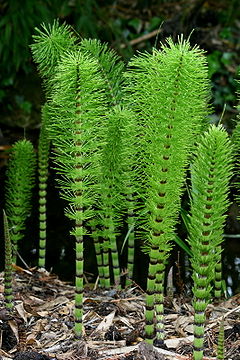Horsetail
|
Equisetum Temporal range: Callovian -Holocene |
|
|---|---|
 |
|
| "Candocks" of the Great Horsetail (Equisetum telmateia subsp. telmateia), showing whorls of branches and the tiny dark-tipped leaves | |
| Scientific classification | |
| Kingdom: | Plantae |
| Class: | Polypodiopsida |
| Order: | Equisetales |
| Family: | Equisetaceae |
| Genus: |
Equisetum L. |
| Type species | |
|
Equisetum arvense L. |
|
| Species | |
|
See text |
|
See text
Equisetum (/ˌɛkwᵻˈsiːtəm/; horsetail, snake grass, puzzlegrass) is the only living genus in Equisetaceae, a family of vascular plants that reproduce by spores rather than seeds.
Equisetum is a "living fossil" as it is the only living genus of the entire class Equisetopsida, which for over one hundred million years was much more diverse and dominated the understory of late Paleozoic forests. Some Equisetopsida were large trees reaching to 30 meters tall. The genus Calamites of the family Calamitaceae, for example, is abundant in coal deposits from the Carboniferous period.
A superficially similar but entirely unrelated flowering plant genus, mare's tail (Hippuris), is occasionally referred to as "horsetail", and adding to confusion, the name mare's tail is sometimes applied to Equisetum.
The pattern of spacing of nodes in horsetails, wherein those toward the apex of the shoot are increasingly close together, inspired John Napier to discover logarithms.
...
Wikipedia
